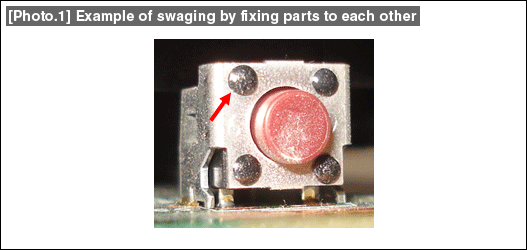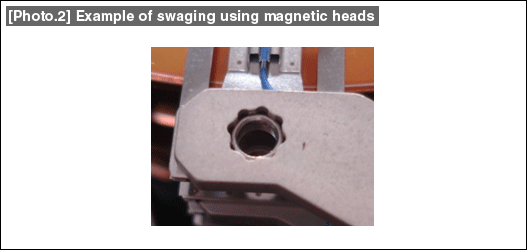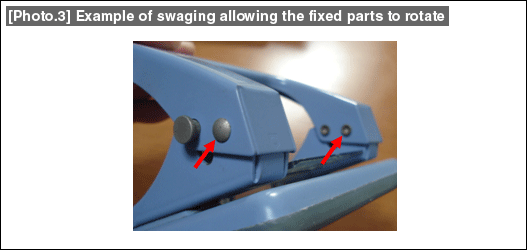HOME > Low Cost Automation Tutorial > #121 Production Technology Improvement Course for Mechanical Designers - 5: Swaging Technology
Low Cost Automation Tutorial
#121 Production Technology Improvement Course for Mechanical Designers - 5: Swaging Technology
Category : Automation elements technology
July20, 2012
Products are generally made by functionally assembling various parts. Product design and assembly/production technology enabling stable product quality at low cost (in other words, products that are easy to make) are key to this assembly process. Additionally, environmental considerations call for products that are free of disposal costs. This tutorial describes "swaging technology," a representative assembly component technology.
(1)What is swaging technology?
| - | Part securing methods include the following: (1) Screw fastening, (2) Adhesives, (3) Press-fitting, (4) Welding, and (5) Swaging. |
| - | Swaging is the deformation of fixing portions of workpieces in order to permanently fix parts to each other. |
| - | There are two types of fixing using swaging: a) fixing parts to each other (Photo 1, Photo 2), and b) fixing parts to each other such that rotary motion is still enabled (Photo 3). |



(2)Characteristics of swaging technology
| 1.Advantages | - Assembly with strong fixing force can be achieved in a short processing time using jigs and automated equipment. - As a method, it is highly reliable and easy to automate. - The swaging process is greatly affected by the design quality at the design stage of the parts to be swaged. |
| 2.Disadvantages | - Investment is required to install jigs and automated equipment. |
- Positioning technology
- Designing and processing
- Sensor Technology
- Automation elements technology
- Clean room technology
- Design hints
- Design tips
- Designing and Machining
- Drive mechanism design
- Hints on designing
- Linear Motion Components
- Locating Technology
- Manufacturing technology
- Motion mechanism design
- Pneumatic Drives
- Production Technology
- Technology Outlook
- General description
- Low-cost automation and materials
- Transfer LCA
- #333 Know-how on automation: Pressurized heating technology - 5: Multilayer pressurized heating process technique
- #332 Know-how on automation: Pressurized heating technology - 4: Points to remember when designing mechanism of pneumatic pressurization method
- #331 Know-how on automation: Pressurized heating technology - 3: Pneumatic pressurization method and pressure profile
- #330 Know-how on automation: Pressurized heating technology - 2: Pressurization method and pressure profile
- #329 Know-how on automation: Pressurized heating technology



